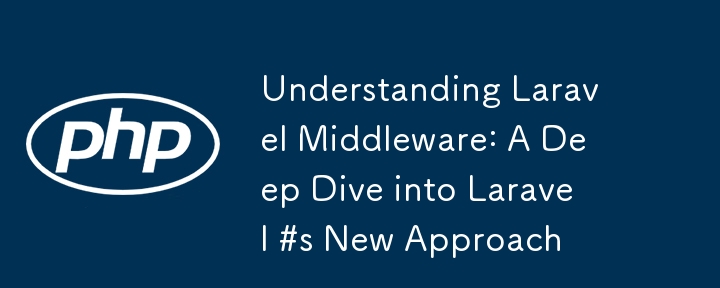了解 Laravel 中間件:深入探討 Laravel #s 新方法
- WBOYWBOYWBOYWBOYWBOYWBOYWBOYWBOYWBOYWBOYWBOYWBOYWB原創
- 2024-09-10 18:30:101579瀏覽

Laravel 中介軟體簡介
中間件是現代 Web 開發中的一個基本概念,Laravel 這個流行的 PHP 框架廣泛使用它來處理 HTTP 請求。無論您是建立簡單的 API 還是大型 Web 應用程序,了解 Laravel 中的中間件都是編寫更清晰、更易於管理且高效的程式碼的關鍵。
在本文中,我們將深入探討 Laravel 中間件,解釋它是什麼、為什麼應該使用它以及如何有效地使用它。我們還將了解 Laravel 11 中的中間件結構,其中發生了重大變化,包括刪除了 HTTP 核心。最後,我們將逐步介紹 Laravel 中自訂中間件的建立和使用。
目錄
- 什麼是中間件?
- 為什麼要使用中間件?
- Laravel 中的中間件類型
- 中介軟體的好處
- Laravel 11 中的中間件結構
- 如何建立和使用自訂中間件
- 使用中間件的實際範例
- Laravel 中介軟體的最佳實務
- 結論
1.什麼是中間件?
中間件本質上是位於傳入 HTTP 請求和應用程式之間的過濾器或層。它會攔截傳入的請求,並在將請求傳遞到下一層之前執行各種任務,例如身份驗證、日誌記錄和請求修改。處理後,中間件可以允許請求繼續傳送到應用程式、修改回應或直接拒絕請求。
簡單來說,中間件就像是應用程式的安全門或守衛。對應用程式的每個請求都必須通過中間件,並且您可以根據請求的類型定義不同的行為。
2. 為什麼要使用中間件?
中間件提供了一個方便的機制來過濾或修改進入應用程式的 HTTP 請求。以下是 Laravel 應用程式中使用中間件的一些常見原因:
身份驗證和授權:中間件可以確保只有經過身份驗證的使用者或具有特定權限的使用者才能存取某些路由。
維護模式:中間件可以檢查應用程式是否處於維護模式,並為所有傳入請求傳回維護訊息。
日誌記錄和監控:中間件可以記錄每個請求或監控效能,幫助開發人員追蹤應用程式效能。
CORS(跨來源資源共享):中間件可以處理 CORS 標頭,允許或拒絕來自外部來源的請求。
請求修改:您可能希望在請求資料到達控制器之前對其進行修改,例如修剪輸入字串或清理輸入。
透過使用中間件,您可以保持應用程式邏輯乾淨,並與橫切關注點(例如安全性、日誌記錄或請求修改)分開。
3. Laravel 中的中介軟體類型
在 Laravel 中,中介軟體一般可以分為三種:
全域中間件
全域中間件適用於進入應用程式的每個 HTTP 請求。它定義一次並自動套用於所有路由。例如,您可能希望為向應用程式發出的每個請求啟用日誌記錄。
特定於路由的中間件
這種類型的中間件僅應用於特定的路由或路由群組。您可以將其附加到單一路由或具有相似行為的一組路由。例如,您可以僅將身份驗證中間件套用至需要登入使用者的路由。
中間件組
中間件組可讓您定義可以作為一個群組一起套用的多個中間件。 Laravel 附帶了一些預設的中間件組,例如 web 和 api 組。這些群組捆綁了應分別應用於所有 Web 或 API 請求的中間件。
4. 中介軟體的好處
中介軟體為 Laravel 開發人員提供了多項好處:
1。關注點分離
中間件透過將特定邏輯與主應用程式流程隔離來幫助分離關注點。這使得維護和擴展您的應用程式變得更加容易,因為應用程式的職責被劃分為不同的層。
2。可重複使用性
一旦定義,中間件就可以在多個路由和應用程式中重複使用。這確保您只需編寫一次中間件邏輯並在必要時應用它。
3。安全
中間件可讓您在應用程式的入口點實現與安全相關的邏輯,例如身份驗證和授權,確保未經授權的請求永遠不會到達您的核心邏輯。
4。客製化
Laravel 中介軟體非常靈活且可自訂。您可以建立中間件來修改請求、根據特定條件重新導向使用者或在回應返回客戶端之前對其進行操作。
5。集中錯誤處理
中間件可讓您以集中的方式管理錯誤和異常。您可以捕獲異常或驗證錯誤並在您的應用程式中統一處理它們。
5. Laravel 11 中的中介軟體結構
Laravel 11 發生了一些重要的結構變化,特別是在中間件的處理方式方面。在 Laravel 11 之前,所有中間件配置都在 Http Kernel 檔案 (app/Http/Kernel.php) 中處理。然而,Laravel 11 引入了一種更乾淨、更模組化的方法。
Http 內核的移除
在 Laravel 11 中,Http 核心已被刪除,中間件現在在 bootstrap/app.php 檔案中配置。對於熟悉傳統 Http 核心結構的開發人員來說,這可能感覺像是一個重大的範式轉變,但它允許以更簡化、更靈活的方式來註冊和管理中間件。
這是 Laravel 11 預設 bootstrap/app.php 檔案的樣子:
<?php
return Application::configure()
->withProviders()
->withRouting(
web: __DIR__.'/../routes/web.php',
// api: __DIR__.'/../routes/api.php',
commands: __DIR__.'/../routes/console.php',
// channels: __DIR__.'/../routes/channels.php',
)
->withMiddleware(function (Middleware $middleware) {
//
})
->withExceptions(function (Exceptions $exceptions) {
//
})->create();
?>```
**Middleware Management**
In Laravel 11, middleware is now handled through the withMiddleware() method, which accepts a callable function. Inside this callable, you can register, modify, or remove middleware.
## 6. How to Create and Use Custom Middleware in Laravel
Creating custom middleware in Laravel allows you to extend the default behavior of your application. Here’s how to create and use custom middleware in Laravel:
Step 1: Create the Middleware
You can create middleware using the Artisan command:
php artisan make:middleware CheckAge
This command will create a new middleware class in the app/Http/Middleware directory. The newly created CheckAge.php file will look something like this:
```php
<?php
namespace App\Http\Middleware;
use Closure;
use Illuminate\Http\Request;
class CheckAge
{
/**
* Handle an incoming request.
*/
public function handle(Request $request, Closure $next)
{
if ($request->age <= 18) {
return redirect('home');
}
return $next($request);
}
}?>```
In this example, the CheckAge middleware checks the user's age and redirects them if they are under 18. If the user passes the condition, the request continues to the next layer.
**Step 2: Register the Middleware**
Since Laravel 11 no longer uses the Http Kernel, you will need to register your middleware in the bootstrap/app.php file. Here’s how you can register your custom middleware:
```php return Application::configure()
->withProviders()
->withRouting(
web: __DIR__.'/../routes/web.php',
)
->withMiddleware(function (Middleware $middleware) {
$middleware->alias('check.age', \App\Http\Middleware\CheckAge::class);
})
->create();```
Now, your middleware alias check.age is available for use in your routes.
Step 3: Apply the Middleware to Routes
Once the middleware is registered, you can apply it to routes or route groups:
```php
<?php
Route::get('/dashboard', function () {
// Only accessible if age > 18
})->middleware('check.age');?>```
## 7. Practical Examples of Using Middleware
Middleware can be used for a variety of tasks in Laravel. Let’s look at a few practical use cases.
**Example 1: Logging Requests**
You can create middleware to log incoming requests to a file or a logging service. This can help you monitor the behavior of your application.
```php
<?php
namespace App\Http\Middleware;
use Closure;
use Illuminate\Support\Facades\Log;
use Illuminate\Http\Request;
class LogRequest
{
public function handle(Request $request, Closure $next)
{
Log::info('Request URL: ' . $request->url());
return $next($request);
}
}?>```
**Example 2: Checking User Roles**
You can use middleware to restrict access based on user roles. For example, only allow access to certain routes if the user has an admin role.
```php
<?php
namespace App\Http\Middleware;
use Closure;
use Illuminate\Support\Facades\Auth;
class CheckRole
{
public function handle($request, Closure $next)
{
if (Auth::user() && Auth::user()->role != 'admin') {
return redirect('/home');
}
return $next($request);
}
}?>```
## 8. Best Practices for Middleware in Laravel
Here are some best practices to follow when working with middleware in Laravel:
**1. Keep Middleware Focused**
Middleware should be responsible for a single task. If you find that your middleware is doing too much, consider splitting it into smaller, more focused middleware.
**2. Use Route-Specific Middleware**
Use route-specific middleware when possible. Applying middleware globally can lead to performance overhead and unnecessary checks on routes that don’t need them.
**3. Avoid Complex Logic**
Middleware should be kept simple. Complex logic or business rules should be handled in the controller
以上是了解 Laravel 中間件:深入探討 Laravel #s 新方法的詳細內容。更多資訊請關注PHP中文網其他相關文章!

